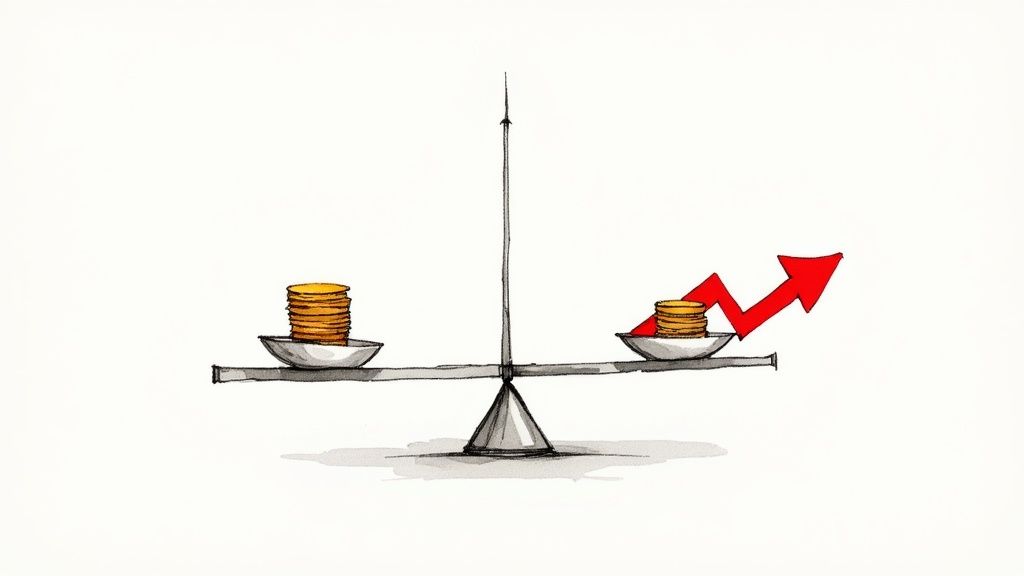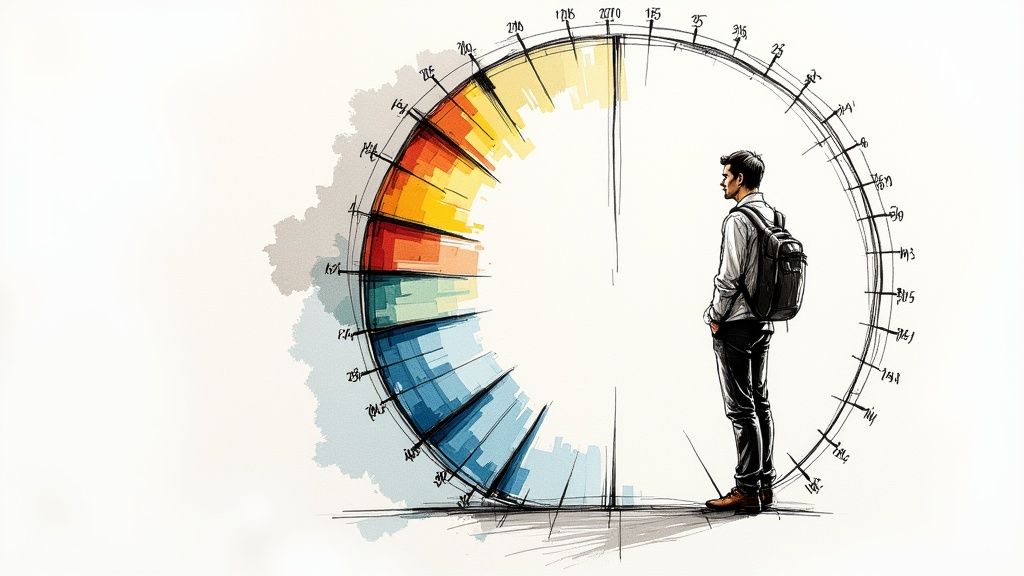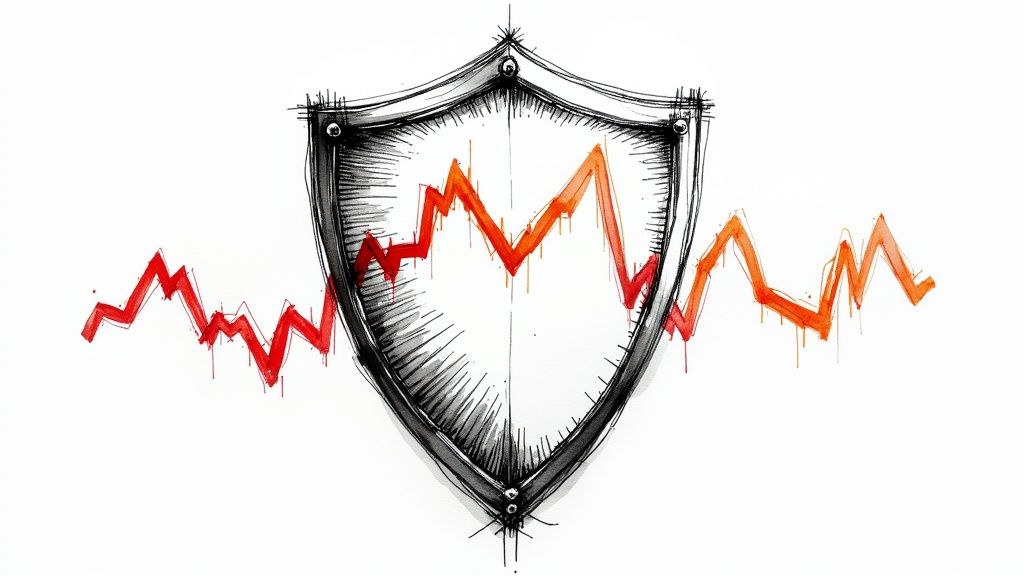Mastering Day Trading Risk Management: Proven Strategies to Protect Your Capital
Understanding the Real Risks in Day Trading
Day trading can appear deceptively simple - buy low, sell high, and watch your profits grow. However, the reality proves much harsher for most who attempt it. This section examines the key challenges day traders face and what makes the small percentage of profitable traders succeed.
The Statistical Reality of Day Trading Losses
The numbers paint a stark picture. Research shows that on a typical trading day, 97% of day traders end up losing money after fees. A comprehensive study from the Taiwan Stock Exchange found that among heavy traders (those trading over $20,000 daily), only 19% generated positive returns after fees. Most sobering is that just 1% of day traders achieve consistent profits. You can find more detailed statistics here: The Data on Day Trading
While success isn't impossible, these statistics highlight why a clear-eyed view of risk and proper risk management are essential before starting. Understanding the odds helps develop strategies to overcome them.
How Successful Traders View Risk
The small group of profitable day traders treat risk differently than most beginners. Rather than seeing it as something to avoid, they analyze risk carefully and manage it systematically. They accept that some losses are unavoidable and focus on keeping them small while maximizing winning trades.
Key practices of successful traders include:
- Protecting existing capital as the top priority
- Taking only well-researched trades with clear risk limits
- Committing to ongoing learning as markets change
This mindset shift from trying to avoid risk to actively managing it marks a key difference between profitable traders and the rest.
Common Misconceptions and Psychological Traps
Several mental biases often trip up new traders and lead to losses:
- False Sense of Control: Believing you can consistently predict short-term price moves
- Overconfidence: Early winning streaks leading to excessive risk-taking
- FOMO Trading: Chasing trades out of fear of missing gains
- Revenge Trading: Making increasingly risky trades to recover losses
Breaking free of these psychological traps requires honest self-reflection and iron discipline in sticking to your trading rules. A solid risk management system provides the structure needed to trade consistently despite emotions.
Essential Stop-Loss Strategies That Actually Work

When it comes to day trading, protecting your money is critical. Basic stop-loss orders aren't enough - you need to know how to use them strategically. Let's look at proven stop-loss methods that can help protect your investments while navigating market swings.
The Importance of Stop-Loss Orders in Day Trading Risk Management
A stop-loss order is a key tool for managing risk in day trading. It automatically sells a stock when the price drops to your specified level, helping limit potential losses. According to recent data, 88% of day traders use stop-loss orders as part of their strategy. While there's debate about their perfect use, they remain essential for protecting trading capital. Learn more at Day Trading Statistics.
Types of Stop-Loss Orders
Beyond basic fixed-price stops, there are more flexible options. A trailing stop-loss moves up as the stock price rises, protecting your gains while still guarding against drops. This differs from a fixed stop that stays at one price point. There's also the time-based stop-loss that closes trades after a set time period, helping you avoid getting stuck in slow-moving positions.
Volatility-Based Stop-Loss Placement
Setting a simple percentage-based stop isn't enough - market volatility matters. When markets are jumpy, you need wider stops to avoid getting knocked out by normal price swings. In calmer conditions, tighter stops can work better. The Average True Range (ATR) indicator helps measure volatility to guide stop placement. Setting stops at ATR multiples provides a buffer against price swings. Check out 10 Best Day Trading Indicators for more insights.
Avoiding Common Stop-Loss Pitfalls
Even good stop-loss strategies can backfire if used poorly. Stops that are too close can cut off winning trades too early. Stops set too far away risk bigger losses. Emotional decisions often derail proper stop placement - fear may make you tighten stops while greed tempts you to widen them. Success requires sticking to your planned risk levels with discipline.
Adapting Your Strategy to Market Conditions
No single stop-loss approach works perfectly all the time. Smart day traders adjust based on market conditions and their trading style. For example, traders chasing momentum might use wider stops during volatile periods to catch big moves. Quick-profit scalpers often prefer tighter stops in steady markets. Regular review and adjustment of your approach helps you stay in sync with changing market conditions.
Mastering Position Sizing for Consistent Returns

The secret to steady profits in day trading isn't just finding winning trades - it's managing your position sizes properly. Smart traders know exactly how much to risk on each trade to protect their capital while maximizing returns. Let's explore how the pros determine optimal position sizing.
What Is Position Sizing and Why It Matters
Position sizing is simply how many shares or contracts you trade at once. While basic in concept, it greatly impacts your bottom line. Good position sizing helps you:
- Stay in the game during losing streaks
- Make the most of winning trades
- Balance risk and reward effectively
Key Position Sizing Principles
Your risk tolerance should guide position sizing decisions. Most traders limit risk to 1-2% of their account per trade to avoid big drawdowns. Consider these factors:
- Asset volatility - more volatile assets need smaller positions
- Account size - larger accounts can handle bigger positions
- The 'one-percent rule' - never risk more than 1% on a single trade
Learn more about managing risk: Day Trading Risk Management
How to Calculate Position Size
Here's a simple method many traders use:
- Set your stop-loss level first
- Calculate the difference between entry and stop-loss prices
- Divide your max risk amount by the per-share risk
- This gives you the right position size
Managing Multiple Trades
Trading multiple positions adds complexity. You need to:
- Track total portfolio risk across all open trades
- Keep combined exposure within safe limits
- Use scaling carefully when adding to winners
Adjusting As Your Account Grows
Your position sizing should evolve with your account balance. While risk percentages stay constant, actual dollar amounts increase. This lets you:
- Benefit from compound returns
- Keep risk appropriate for account size
- Avoid the temptation to overtrade
Stay disciplined with position sizing - it's vital for long-term trading success.
Avoiding Career-Ending Risk Management Mistakes

Even with solid knowledge of position sizing and stop-loss orders, day traders can make serious mistakes that put their entire trading career at risk. Let's explore some of the biggest risk management errors and how to steer clear of them.
The Danger of Overleveraging and Revenge Trading
Overleveraging is one of the quickest ways to blow up your trading account. This happens when traders take on too much borrowed money, which can multiply both gains and losses. When overleveraged traders hit a losing streak, they risk getting a margin call and losing everything. For example, using 10x leverage means a 10% drop in the asset's price wipes out 100% of your capital.
Many traders fall into revenge trading after big losses. They rush into risky new trades trying to make back their money fast. This emotional response usually backfires and leads to even bigger losses. Staying calm and controlled is essential in day trading - revenge trading is the opposite of that approach.
Ignoring Stop-Loss Orders and Risking Too Much Per Trade
Stop-loss orders are crucial safety tools that automatically limit your downside when trades go against you. Skipping stop losses or placing them too far away opens you up to massive losses that can trigger margin calls or drain your account. For example, a trader with a 75% win rate still lost money overall by not using proper stops because their losses were too big. Learn more about this topic: Understanding Stop-Loss Importance.
Putting too much money into single trades is another major risk. While many traders follow the 2% risk per trade rule, going beyond this limit, especially on untested setups, can quickly eat through your capital even if you win most trades. This makes you very vulnerable when markets move unexpectedly.
Lack of a Trading Plan and Inconsistent Risk Management
Success in day trading requires having a clear trading plan that spells out your strategies, entry/exit rules, and risk limits. Trading without a plan makes you more likely to make emotional decisions based on market noise. This lack of structure often leads to poor trading choices.
You also need to apply your risk management rules the same way every time. A few winning trades where you ignore risk limits can make you overconfident, encouraging more risky behavior that eventually causes big losses. Sticking to your risk rules consistently matters more than short-term results.
Failing to Adapt to Changing Market Conditions
Markets are always changing, and strategies that work in one environment may fail in another. Smart traders regularly check market volatility, liquidity, and trends to adjust their risk management. For example, you might need wider stop losses during volatile periods. If you don't adapt, you risk unexpected losses and miss good opportunities. Being flexible helps keep your risk management effective at protecting your money.
Building Your Complete Risk Management System
A solid risk management system is essential for success in day trading. Just like a well-built fortress, your system needs multiple layers of protection - from analyzing trades beforehand to reviewing them afterwards.
Developing a Systematic Approach to Risk Assessment
Before any trade, focus on thorough risk assessment. Look beyond potential profits and examine what could go wrong. Ask key questions: What's the worst outcome? What's my maximum acceptable loss? What market moves could hurt this trade? This analysis forms the core of your risk management. For deeper insights into testing strategies, check out this guide to backtesting trading strategies.
Creating Personalized Risk Scorecards
A risk scorecard helps make pre-trade analysis more concrete. Score different risk factors based on your trading approach. Consider things like market volatility, news impact, technical signals, and your confidence level. Higher scores mean higher risk, helping you decide whether to reduce position size or skip the trade entirely. This brings objectivity to risk evaluation.
Implementing Effective Monitoring Systems
Active trade monitoring is critical. Set up real-time alerts and watch your charts closely to spot any shifts from your plan. Know your exit points - both for cutting losses and taking profits. Good monitoring keeps you on track and ready to act when markets change.
Maintaining Discipline Under Pressure
Market stress can challenge even experienced traders. The key is sticking to your risk plan despite emotional pressure. Avoid jumping into trades based on fear or greed. Simple techniques like deep breathing help maintain focus. Remember: your risk system only works if you follow it consistently.
Building Supportive Habits
Strong risk management needs good daily habits. Keep detailed trading records to track what works and what doesn't. Review both winning and losing trades to find ways to improve. Set up a routine: prepare before market open, assess risks carefully, and review after close. These practices help you trade well even when markets get tough.
Implementing Your Daily Risk Management Routine

Success in day trading comes down to putting risk management principles into daily practice. Building solid routines around controlling risk and spotting opportunities is what sets profitable traders apart. Let's explore how to create an effective daily routine through preparation, execution, and review.
Pre-Market Preparation: Setting the Stage for Success
Smart traders do more than just look for hot stocks before the market opens. They create a solid foundation by:
- Market Analysis: Checking overall market mood and key economic news that could impact trading
- Strategy Review: Making sure chosen strategies match current conditions and adjusting stop-losses/targets as needed
- Watchlist Creation: Selecting a focused list of stocks meeting specific criteria instead of chasing every opportunity
- Risk Limits: Setting clear maximums for risk per trade and total daily losses
This structured preparation helps prevent emotional decisions once trading begins.
Intraday Discipline: Maintaining Focus and Control
During market hours, staying focused and controlled is critical. Here's how successful traders maintain discipline:
- Morning Checklist: Starting with a clear list that reinforces key risk principles and their trading plan
- Pre-Trade Risk Check: Carefully evaluating potential losses before entering positions, considering factors like volatility
- Active Position Management: Monitoring open trades closely and adjusting stops/targets based on price action
- Emotional Control: Following the plan even during volatile periods or unexpected moves
Following these practices consistently helps build strong trading habits and reduces emotional mistakes.
Post-Session Review: Learning and Refining Your Approach
The work isn't done when the market closes. Top traders know reviewing their performance is essential:
- Trading Journal: Recording all trades with entries, exits, reasons, emotional state, and lessons learned
- Performance Metrics: Looking at win rate, profit/loss ratios, and drawdowns to find areas to improve
- Strategy Updates: Fine-tuning approaches based on what worked and what didn't
This review process turns each day into a learning opportunity. For instance, seeing a pattern of losses during volatile times might lead to reducing position sizes in those conditions. Studying winning trades helps identify the best setups for specific strategies.
Making these risk management practices part of your daily routine builds the foundation for steady profits over time. When done consistently, they become automatic - giving you an edge in the challenging world of day trading.
Ready to improve your trading analysis? ChartsWatcher offers powerful tools to help implement effective risk management strategies.

